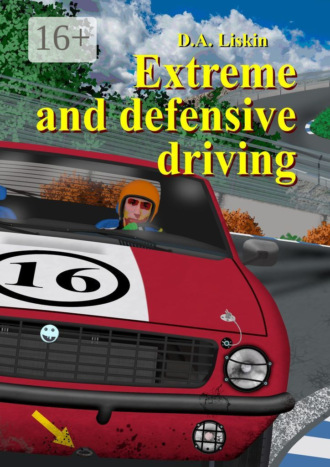
Полная версия
Extreme and defensive driving. 2nd expanded edition
• skid of rear loaded wheel should not occur;
• differential friction should not be too high;
• drift angle should not be greater, than about 45 degrees.
The last two requirements are very conditional. Performing of the technique may differ on different machines, so you need to perform concrete tests. It is not difficult to test “throttle+brake” technique: you just need to provoke a drift and press the throttle and brake pedals.
It was not said, but was obvious, that to perform the above-listed techniques an anti-lock system should not be installed on car, which prevents the wheels from locking by the brake system. In the presence of an anti-lock system it is impossible to perform defensive “throttle+brake” technique on a rear-wheel-drive car.
Recommendations for driving a car in a drift
• while driving car in a drift, your hands should be relaxed, you do not need to hold the steering wheel with a death grip;
• while drift turn your head and direct your gaze along the direction of movement of car, keep the hood in the background, so you will definitely feel angle of drift;
• when fighting with a deep drift direct your gaze forward, through the windshield – this will help you maintain your orientation in space.
Notes on performing of “throttle+brake” defensive technique on a rear-wheel-drive car
• during perform the technique you should to straighten the front wheels or turn them by the steering wheel in the direction, in which you want to continue move at the end of the technique;
• if the engine torque is quite high and the rear wheels start to skid when performing the technique, you need to limit effort on the throttle pedal: the traction on the rear axle is only needed to unload the front;
• the duration of the technique is controlled according to trajectory of movement.
Exercise 1. Work out the skills of getting out from drift with help of steering. Actions will vary depending on the type of drive: on front-wheel-drive type it is necessary to increase the traction and to turn the steer against direction of drift, on rear-wheel-drive – you need to let go of the throttle pedal, press the clutch pedal and direct the front wheels in the direction of motion (you should to rotate the steer against the direction of drift until desired position of the front wheels).
Be careful! When exiting a drift on a rear-wheel-drive car there should not be a long pause after turning the steer against direction of drift. Otherwise there may be a response from the car, and there will be a rhythmic drift. As soon as drift has started to stop, you need to immediately return the steer to the “straight” position.
Exercise 2. Create oversteer on a front-wheel-drive car at the entrance to a long corner (arc) with help of “throttle+brake” technique. Repeating the training, try to gradually increase speed of entering the corner.
Exercise 3. On a rear-wheel-drive car, press the throttle pedal at the exit of a corner, to trigger drift. Without releasing the throttle pedal, sharply hit the brake pedal with your left foot, to eliminate the drift. After stopping drifting release the pedals and restore trajectory by the steer motions. Repeating the exercise, determine angle of drift, more than which the technique “throttle+brake” does not work. Limit effort on the throttle pedal if there is a skid of rear loaded wheel and efficiency of “throttle+brake” technique decreases.
Remember that on a front-wheel-drive car one time pressed the throttle and brake pedals increases steerability, while on a rear-wheel-drive car – they decrease it. If this is the first time when you are perform the technique, limit speed and provide braking distance enough in all possible directions.
Exercise 4. On rear-wheel-drive or all-wheel-drive cars, prepared for drift, the exercises “ring”, “eight” and the passage of a hairpin with drift of the rear axle will be useful. Rings should be selected in different diameters to work out different speed modes.
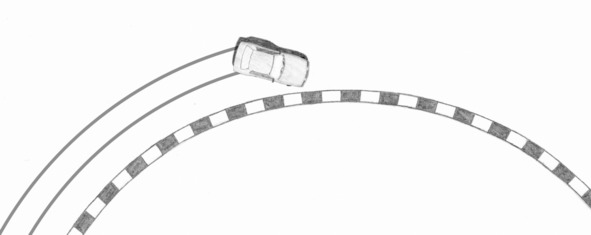
We press the throttle pedal with pulses, as if groping for optimal traction, and at the same time we steer. Our goal will be a stable retention of trajectory radius and minimal fluctuations in drift angle.
Exercise 5. Go through a 180-degree turn (hairpin) with the rear axle drifting. At entrance to the corner provoke drift by rocking, handbraking or including a low gear.
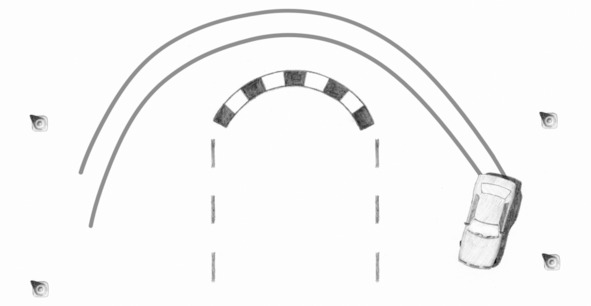
At exit of the corner maintain drift by alternately pressings the throttle pedal. Try to get maximum acceleration at exit of the hairpin.
Exercise 6. Another useful exercise for training driving a car in a drift is the “eight”. In the middle of the eight we perform the so-called reversal: we accelerate car, then release the throttle pedal and rotate the steering wheel in the opposite direction when moving to the next half of the eight.
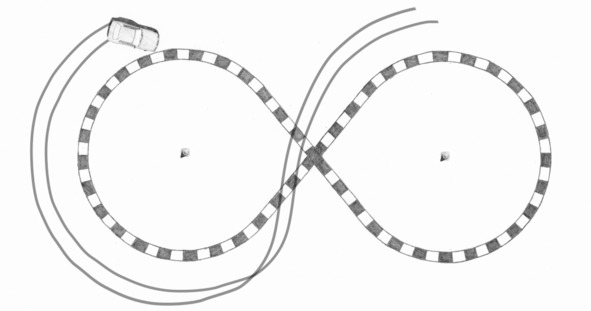
If there is feedback on the steer it should start to rotate itself against the direction of drift. The feedback force depends on the castor in a car and settings of the feedback force in a car simulator.
Exercise 7. Try to cause the front axle to drift while reverse moving by sharply turn of the steer. Do not forget to squeeze the clutch, so that the engine does not stall during skidding.
Practical advices for a driver
1. Use light footwear with soft, non-thick, flat soles for driving. Rightly chose footwear will help you feel the pedals better. In any case do not drive a car in “flip-flops”, slippers or shoes with a long heel, this can lead to an accident situation. If footwear has a heel, it should not be long. Shoelaces are also dangerous. Scarves, ties, long sleeves, hair, and wired headphones can also interfere for driving.
2. Wear gloves while driving. In gloves with a rubberized palm (so-called “dipped” gloves) or leather gloves hands cling better to the steering wheel and the gear lever, and hand tires less during driving. If you are a novice racer, you may get “dipped” gloves for training, which you can buy at any building supplies store.
3. Place your hands on the steering wheel at 9 and 15 o’clock or 10 and 14 o’clock (according to the clock face). In these positions you can comfortably rotate the steering wheel within about 200 degrees. If you need to turn the steering wheel at a greater angle – continue rotation of the steer with change of hands position. A steering error will be crossing of hands in the lower sector of the steering wheel.
4. Use right steering wheel. Spokes of the steer should not prevent hands from being placed in the 9 and 15 o’clock or 10 and 14 o’clock positions and fingers from squeezing the steering wheel in these positions. It is possible placing of the spokes, in which they pass under or above hands – so you will feel right position of hands on the steer. It is not recommended to use a steering wheel cover, as it will dull feels, received from the steering wheel.
5. Take into account condition of the road surface to choose speed of movement. Let us assume, that you are on an unfamiliar road or road state may have changed significantly recently due to weather conditions. You may estimate condition of the road surface with help of braking with wheels locking. At low speed (10—15 km/h), hardly press the brake pedal to lock the wheels, and wait for stop. The worse the grip, the greater braking distance. When you get more experience a short-time wheels lock will be enough to estimate a road surface. This skill is very useful in winter: for example, a situation may be when the road is snow covered, and there – is bare ice under the snow, which a driver does not suspect.
6. Do not listen to music when driving. This takes away your attention and impairs your concentration on driving. The same applies to conversations on cell phone. A missed beep or even a scream can cause inconvertible events.
7. Do not move in neutral gear. Some drivers, trying to save on fuel, move downhill and enter corners in neutral gear. This makes driving a car unsafe. Disconnecting the engine from the transmission makes it impossible to control a car with help of engine’s torque. The throttle pedal – is a very important element of controls in both front-wheel-drive and rear-wheel-drive vehicles.
8. Do not keep your hand on the gear lever. Many drivers drive in city traffic a car with a standard gear box in a relaxed pose, when left hand is on the steering wheel and right hand – is on the gear lever. Both hands should be placed on the steering wheel. Right hand moves to the gear lever only when it is necessary to change the gear.
9. Don’t hunch over while driving. Incorrect posture impairs view from the cockpit, especially view from the side windows. Peripheral vision improves spatial orientation and, as a result, vehicle control accuracy. To get full view, proper fit is necessary, driver’s back should be straight and close to the seat, and head – look straight.
Turnaround while reversing (police turn)
Police turn is familiar to many from films. It is rumored that drivers of the special services keep it on board. Police turn allows you to quickly turn a car around with help of front axle drift, which can be created while driving in reverse.
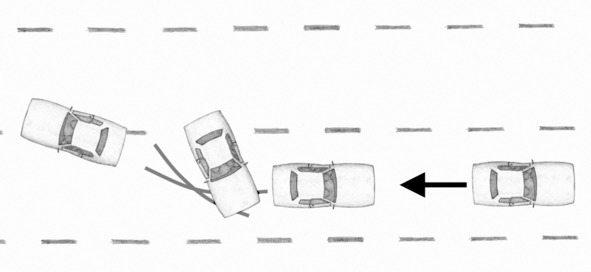
Despite seeming from the outside difficulty of the technique, it is quite simple to perform. Consider performing the technique on front-wheel-drive and rear-wheel-drive cars.
Rear-wheel-drive
Firstly it is necessary to select the reverse gear and accelerate along a straight section of trajectory. It should be noted, that during reversing after releasing the throttle pedal the engine starts braking. Engine braking – is a braking torque (some kind of braking effort). Braking on the rear axle while driving in reverse creates understeer, similar to how high braking effort on the front wheels causes sliding of the front axle when driving ahead. Therefore after performing acceleration it is necessary to disconnect the engine and transmission before performing the technique.
To produce drift of the front axle, you need to quickly turn the steer. After drift occurs, wasted no time, it is necessary to immediately return the steer to the straight position. When longitudinal speed will be zero, the first gear can be switched on. Let us show at the figure performance of turnaround.
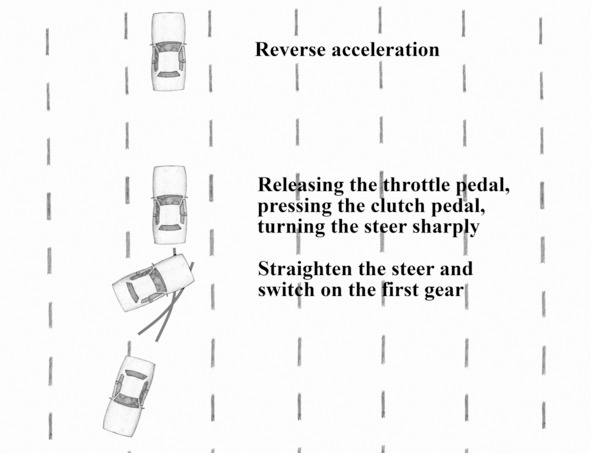
Initially we were moving in a straight line in reverse, but deviated from the straight line and after performing turnaround left the marked lane. Drifting of the front axle did not begin immediately: at beginning turn of the steer the car deviates from straight trajectory.
To stay in the lane, during acceleration it is needful to slightly deviate from straight line movement with a short movement of the steer to the side, opposite to direction of turning. It is important to do this during acceleration – if there is no traction on the rear axle when the steer deviates from the “straight” position, the car will start to turn around. Preliminary shift in the opposite side not only increases space for maneuver, but also intensify further sliding of the front axle due to rocking. Let us show at the figure performance of reverse turn with a preliminary deviation.
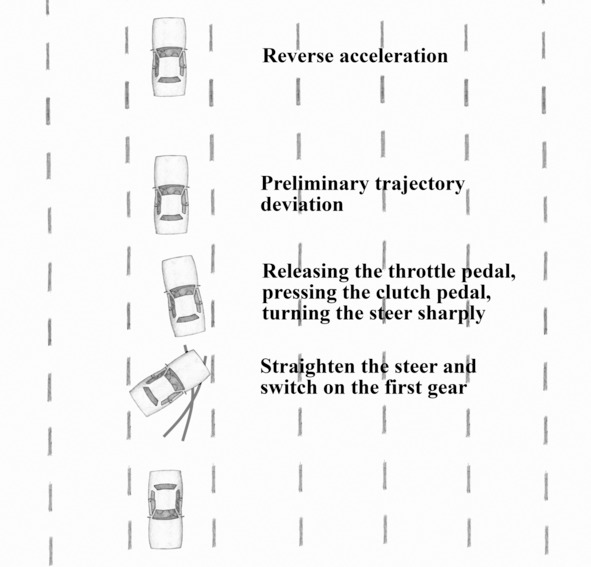
As you can see, we succeed to stay within the marked lane.
If a car does not respond well to performing police turn, you can use at one time pressing of the throttle and brake pedals. Engine torque, transmitted to the rear axle, will prevent the rear wheels from braking, but high braking effort on the front wheels will lock them, causing a car to turn around. Let us illustrate at the figure reverse turn perform using the throttle and brake pedals.
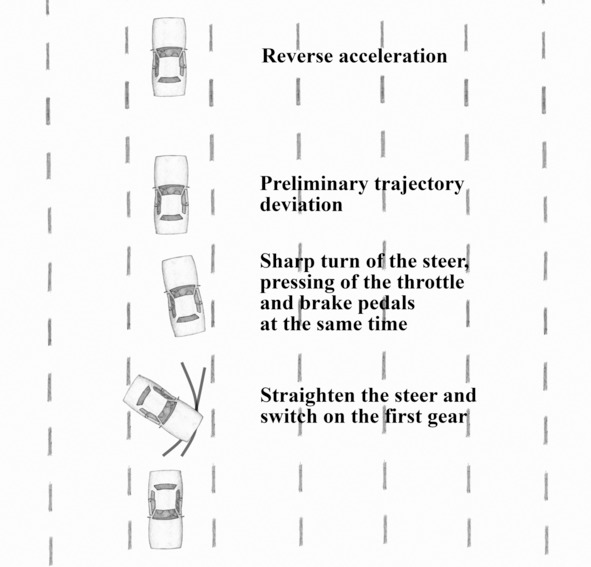
Front-wheel-drive
On a front-wheel-drive car engine braking when reversing creates oversteer. We should seize this. But so that the engine does not stall during perform the technique, it is necessary to press the clutch, when engine speed drops to idle. Let us show at the figure performing a turnaround on a front-wheel-drive car.
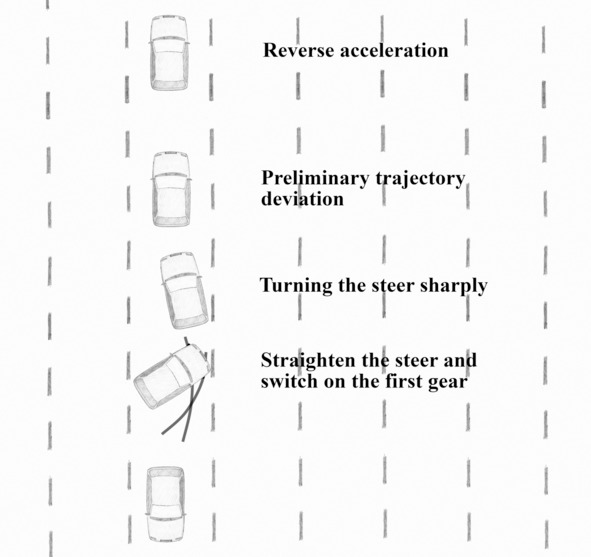
Preliminary deviation should be performed by a very short and smooth steer motion, as a car may start to turn around. On rear-wheel-drive traction on the rear axle protects from turning, which is not present on a front-wheel-drive car during acceleration.
Regardless of the type of drive, some machine settings contribute to perform of turnaround. Shifting the center of mass to the rear axle (a small proportion of the weight on the front axle) will make it easier turn of the front axle around the rear axle. Besides, the more a car shows understeer when driving ahead, the more oversteer will occur when driving reverse. Therefore understeer will be another positive point for performing a police turn. So, factors, that affect steerability when driving in reverse are as follows:
• shifting the center of mass to the rear axle;
• understeer when moving ahead.
Steerability when moving reverse affects on success of turnaround performance. A turnaround while reversing can be performed with help of a rightly set of the brake system.
Exercise 1. Try to perform a police turn on a rear-wheel-drive vehicle in all the ways, described in this chapter for rear-wheel-drive cars. Which of the ways to perform a turnaround is the most optimal for your car?
Exercise 2. Perform a police turn on a front-wheel-drive vehicle. Be careful when performing a preliminary deviation, as front-wheel-drive vehicle shows oversteer during reverse acceleration (opposite to a rear-wheel-drive vehicle, which shows understeer during reverse acceleration).
Exercise 3. What settings must be changed, to increase car’s steerability when reversing? Test steerability of reversing at different settings.
Return from an obtuse drift angle
Turnaround of a car on the road is unlikely, but it can be quite dangerous, if it happens for some reasons when moving at high speed. When sliding at a large angle (90—180 degrees), it is impossible to control trajectory of movement and predict behavior of machine. An untrained driver will not be able to take any correct actions during turnaround of a car to overcome drift.
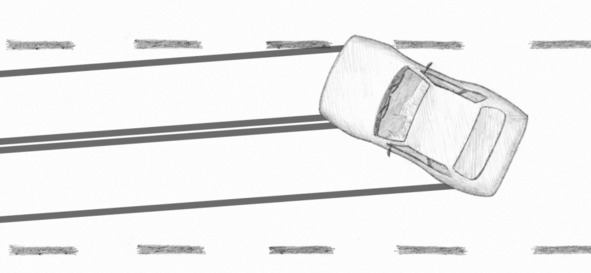
It is known, that on a front-wheel-drive car it will not be difficult to get out of almost any drift angle – it is just needful to press the throttle pedal and turn the steer. For a rear-wheel-drive car there is an effective “throttle+brake” technique, but drift angle, which can be overcome by this technique, is limited. Regardless of the type of drive, machine can be quickly returned, using dosed braking effort in definite range of drift angles.
Let us try an experiment. We will move around a ring in reverse. While moving, press the brake and clutch pedals all the way down.
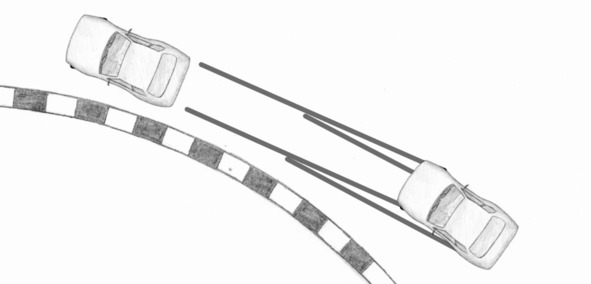
The sports car’s braking system is very powerful and can lock both the front and rear wheels. After pressing the clutch and brake pedals all the wheels locked, and the car continued to slide move in a straight line. The front wheels locked a little earlier than the rear ones. The final position of the body is at small angle relative to the initial position. Let us repeat the test with less effort on the brake pedal.
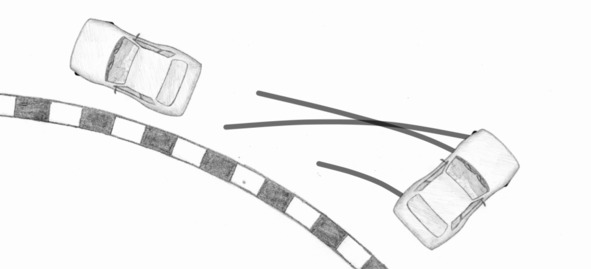
When the brake pedal was pressed, both the front wheels and rear left wheel locked. The car almost turned around. If initial speed of movement was greater, the car would most likely perform a turnaround before stopping. Braking efforts on both rear wheels are the same, but at the beginning of braking weight of the car puts more pressure on rear right wheel, than on rear left wheel. Therefore braking effort, which should lock right rear wheel, must be higher, than braking effort on the rear left wheel. In the next test we will push the brake pedal even more weakly, but we will try to provoke lockage of the front wheels.
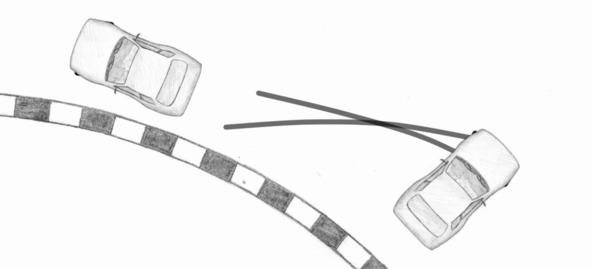
After pressing the brake pedal both front wheels locked, both rear wheels rotate, until the car stopped. The results are similar to the previous test: the car began to turn around after pressing the brake pedal. On all cars, as a rule, brakes of the front wheels are much stronger than brakes of the rear. If the brake system is correctly set, when the brake pedal is fully pressed when moving on an asphalt road in reverse in a corner or in an obtuse slide angle both front wheels must lock, and the rear – continue to rotate.
Based on the previous experiments, let us formulate test for performing a car turnaround with help of the brake system.
Turnaround test when reversing with help of the brake system. While reversing around a ring, abruptly push the clutch and brake pedals to the end. Both front wheels must lock, rear loaded wheel must not lock. After pressing the pedals car should turn around.
Locking of the front wheels when the brake pedal is pressed must occur for any level of wheel loading. For example, when a car move in a drift, the body rolls, and some wheels are loaded, others – are unloaded. If the braking system is weak, front loaded wheel may not lock.
The test must be performed in clockwise and counter-clockwise move directions, since the braking system can work “criss-cross”, creating slightly different braking efforts for wheels on the same axle (depending on correct setting of the braking system).
Practice shows, that turning around with help of the brake system is not effective, if drift angle is close to 180 degrees or equal to 180 degrees (reverse moving). When pressing the brake pedal the front wheels lock, there is braking effort on the rear wheels, but car will not turn around. Therefore firstly it is necessary to deflect trajectory by turn the steer, after which already lock the front wheels with the service brake. In addition, drift angles in range of approximately 90—140 degrees are also unsuitable for performing turnaround using the brake. While moving in drift at these angles rotation speeds of wheels is low and their locking will not significantly change angle of drift.
On a rear-wheel-drive car you can increase angle of drift, if you cause the rear wheels to skid (gain engine speed in first or second gear and release the clutch pedal). On a front-wheel-drive car wheels skidding should reduce drift angle. On both front-wheel-drive and rear-wheel-drive vehicles the torque and inertia moment of the engine should be enough to cause the drive wheels to skid. In addition, to create skidding of driving wheels, anti-skid system (traction control) should not be installed on car.

The figure shows performing turnaround using the brake, when the car is moving in deep slide. In the chapter “Turnaround while reversing (police turn)”, it was noted, that the success of turnaround is affected by reverse steerability, namely – it should not be too low. The same requirement applies to performing turnaround with help of the brake.
Requirements for successful return from an obtuse drift angle with help of the brake system
• when moving in an obtuse drift angle after pressing the brake pedal to 100%, the front wheels must lock, rear loaded wheel must maintain rotation;
• drift angle should be high enough, but should not be close to 180 degrees (reverse moving), approximate angle range – is from 140 to 160 degrees;
• steerability of reverse moving should not be too low.
Let us try another experiment. When the car is in drift (angle of about 150 degrees), turn the steer to stop in direction of increasing drift angle. We will assume, the car is moving in neutral gear or with pressed clutch pedal, and the front wheels are in the “straight” position.
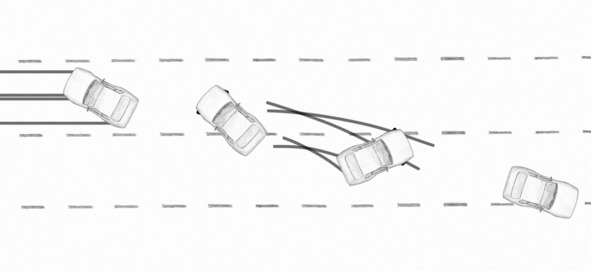
As we can see, after turning the steer the car began to slowly turn around. Trajectory was slightly curved. Tyre traces were interrupted, as the car moved almost in reverse for short distance. Steer turn allowed not only to turn around, but also to bend trajectory against the direction of drift. We observed similar trajectory bending, when performing a police turn (trajectory bending was undesirable, we tried to eliminate it with help of preliminary deviation).
Let us compare two ways of return from drift with an obtuse angle: by locking the front wheels and turning the front wheels.
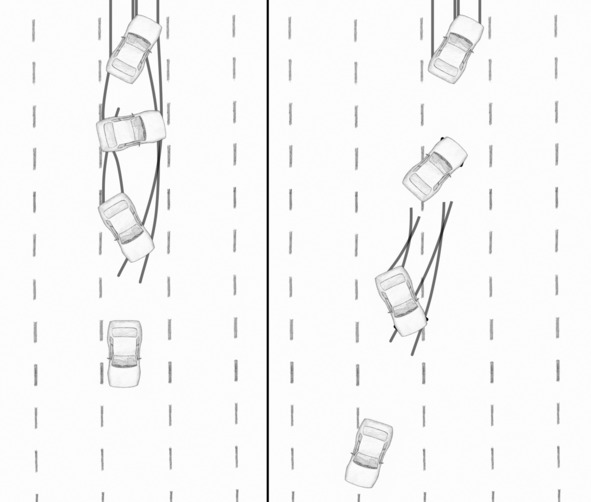
Left part of the figure shows turnaround, made by locking the front wheels, and the right part – shows turnaround, accomplished by turning the steering wheel (police turn). Turnaround of the car with help of the brake system is faster and trajectory is generally close to straight line. The second method, unlike the first, allows you to deflect trajectory in the direction, where rear part of car looks when moving in drift (when the front wheels are locked, there is also deflection of trajectory, but it is very small). Moreover the higher steerability when reversing, the faster turnaround will occur after turning the steer and the less curvature of trajectory will be.
Aerodynamic elements, which increase side resistance to air movement of rear part of the body, can contribute to passive safety of a car.

At the figure hatch marks the rear antiwing. When drifting occurs when moving at high speed, such aerodynamics on the rear of a car can create an effort, which prevents increasing of drift. Like tail of an arrow, which stabilizes it in flight, aerodynamic elements on the rear of a car prevent occurrence of drift, but, at the same time, reduce steerability. And the higher speed of movement – the stronger effect. At low move speed and correspondingly low air flow rate the aerodynamics will not affect behavior of the vehicle. Using such of aerodynamics is justified: to pass high-speed corners it is not needful for high steerability, as angles of corners are small, but for passing slower and sharp corners (for example, hairpins) need high steerability.
Notes on performing turnaround with help of the brake system
• if car has a powerful braking system, which can lock all wheels or road surface has a low grip on tyres (wet asphalt, snow-covered road), it is necessary to limit effort on the brake pedal, so as not to lock rear loaded wheel;
• if car has already started to turn when performing turnaround, you may release the brake pedal;
• when the front wheels are in locked condition, you should to straighten them – so that car remains neutral behavior after releasing the brake pedal;
• after drift angle becomes small (approximately 10—30 degrees), you may switch to tackle control by working the steer;



